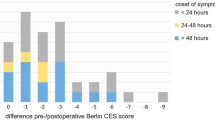Abstract
Introduction
Cauda Equina Syndrome (CES) is one of the genuine orthopaedic emergencies. Diagnosis of acute CES is challenging and may be missed, resulting in considerable medicolegal claims. In Ireland, nearly €21 million in compensation has been paid out over a 10-year period due to the diagnosis being missed. As a result, defensive practices have resulted in an increased number of referrals for CES to the on-call orthopaedic service in a major trauma unit.
Methods
A prospective data-capturing exercise was carried out of all referrals for acute CES to the orthopaedic on-call department in a tertiary-level university-affiliated teaching hospital between August and November 2023. Qualitative data was captured including referral source, referring clinician grade, in-hours or out-of-hours referral, MRI on referral, red flags as identified by the referring team, red flags as identified by the orthopaedic team, and outcome.
Results
Forty referrals for CES were made over the duration of this audit. Seventeen (42.5%) referrals were made in-hours, and 23 (57.5%) were referred out-of-hours. Only five (12.5%) of these referrals had an MRI done at the time of the referral. No patients were transferred for an out-of-hours MRI to another hospital. Only five (12.5%) patients required surgical decompression—none of these patients required an out-of-hours emergent decompression.
Conclusion
There is a lack of understanding as to what exactly is being referred—resulting in a referral volume which is over ten times the expected number of CES cases being made to our unit. The lack of out-of-hours MRI access poses a significant concern for patient outcomes.
Similar content being viewed by others
Data availability
The data presented in this study are available on request from the corresponding author.
References
Lavy C, Marks P, Dangas K, Todd N (2022) Cauda equina syndrome-a practical guide to definition and classification. Int Orthop 46(2):165–169
Hoy D, Bain C, Williams G et al (2012) A systematic review of the global prevalence of low back pain. Arthritis Rheum 64(6):2028–2037
Milsom I, Gyhagen M (2019) The prevalence of urinary incontinence. Climacteric 22(3):217–222
Agency SC. Available from: https://stateclaims.ie/learning-events/cauda-equina-syndrome
Hoeritzauer I, Wood M, Copley PC et al (2010) What is the incidence of cauda equina syndrome? A systematic review. J Neurosurg Spine 14:1–10. https://doi.org/10.3171/2019.12.SPINE19839. Epub ahead of print. PMID: 32059184
Woodfield J, Lammy S, Jamjoom AAB et al (2022) Demographics of cauda equina syndrome: a population-based incidence study. Neuroepidemiology 56(6):460–468
Hospital TU. Available from: https://www.tuh.ie/About-us/Capital-Development-Plans.html
A trauma system for ireland. Report of the Trauma Steering Group. https://assets.gov.ie/10116/70fd408b9ddd47f581d8e50f7f10d7c6.pdf
Gleave JR, Macfarlane R (2002) Cauda equina syndrome: what is the relationship between timing of surgery and outcome? Br J Neurosurg 16(4):325–328
Todd NV, Dickson RA (2016) Standards of care in cauda equina syndrome. Br J Neurosurg 30(5):518–522
Hoeritzauer I, Paterson M, Jamjoom AAB et al (2023) Cauda equina syndrome. Bone Joint J 105-B(9):1007–12
Todd NV, Casey A, Birch NC (2024) The failure of subcategorization of cauda equina syndrome. Bone Joint J 106-B(3):227–31
Todd NV (2017) Guidelines for cauda equina syndrome. Red flags and white flags Systematic review and implications for triage. Br J Neurosurg 31(3):336–9
Todd NV (2015) Cauda equina syndrome: is the current management of patients presenting to district general hospitals fit for purpose? A personal view based on a review of the literature and a medicolegal experience. Bone Joint J 97-B(10):1390–4
(GIRFT) GIRFT. National suspected cauda equina pathway 2023. Available from: https://gettingitrightfirsttime.co.uk/wp-content/uploads/2023/10/National-Suspected-Cauda-Equina-Pathway-UPDATED-V2-October-2023.pdf
Hussain MM, Razak AA, Hassan SS et al (2018) Time to implement a national referral pathway for suspected cauda equina syndrome: review and outcome of 250 referrals. Br J Neurosurg 32(3):264–268
Silva A, Sachdev B, Kostusiak M et al (2021) Out of hours magnetic resonance imaging for suspected cauda equina syndrome: lessons from a comparative study across two centres. Ann R Coll Surg Engl 103(3):218–222
Fountain DM, Davies SCL, Woodfield J et al (2019) Evaluation of nationwide referral pathways, investigation and treatment of suspected cauda equina syndrome in the United Kingdom. Br J Neurosurg 0(0):1–11
Author information
Authors and Affiliations
Corresponding author
Ethics declarations
Ethics approval
This study was performed in line with the principles of the Declaration of Helsinki. Approval was granted by the ‘Clinical Audit’ review board in our hospital and permission was granted to carry out this audit (submission number 3236).
Consent to participate
No patient consent was required for this audit as no identifying or personal information was included.
Conflict of interest
The authors declare no competing interests.
Additional information
Publisher's Note
Springer Nature remains neutral with regard to jurisdictional claims in published maps and institutional affiliations.
Rights and permissions
Springer Nature or its licensor (e.g. a society or other partner) holds exclusive rights to this article under a publishing agreement with the author(s) or other rightsholder(s); author self-archiving of the accepted manuscript version of this article is solely governed by the terms of such publishing agreement and applicable law.
About this article
Cite this article
Keohane, D., McGoldrick, N.P. & Quinlan, J.F. A prospective review of Cauda Equina Syndrome referrals received by an on-call orthopaedic department at a major trauma unit. Ir J Med Sci (2024). https://doi.org/10.1007/s11845-024-03678-6
Received:
Accepted:
Published:
DOI: https://doi.org/10.1007/s11845-024-03678-6




